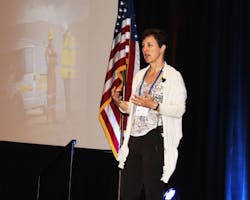Caterpillar is great example of how a large equipment manufacturer is transforming its business model by leveraging modern technology. The company, which caters to three industries—resource industries (mining), construction, and energy/transportation (power/compulsion systems for marine, oil & gas, turbines and locomotives)—has always looked at service as an important part of its offerings.
Historically, servicing big tractors was an intense outside physical activity that could also be cold and muddy. By the 1980s, Caterpillar’s service had become less physical and more about software and electronics. The company put electronics on the equipment and optimized them with onboard controls. That led to an electronic service tool that could be brought on the work site to service the equipment.
Today, service is evolving again, as it is done remotely using telematics devices that can do onboard diagnostics and send alerts and diagnostic codes back to the equipment experts. In addition, Caterpillar is now moving into the next layer of technology in the service domain which includes the Industrial Internet of Things (IIoT), as well as augmented and virtual reality.
The company’s modern technology mission: “To be cheaper, smarter and faster,” said Terri Lewis, digital and technology director at Caterpillar, during her keynote presentation at the Automation Conference & Expo this week in Chicago, which is produced by PMMI Media Group.
In fact, the Caterpillar IIoT initiative was launched as a vision in the 1990s with a goal of leveraging the Internet for service. Today, the company has 186 dealers and about 500,000 connected assets around the world upon which service technicians can conduct an inspection simply by sending photos for analysis via a smartphone.
“We have entire mine sites connected and interacting to make split-second decisions,” Lewis said. “Now we want to connect people and products.”
Caterpillar created a way to use a mobile phone to access real-time data coming off of a generator set (genset). In March of this year, the company went live with a genset remote monitoring capability and will deliver a secure remote start/stop control by the end of this year.
Now, beyond remote monitoring, “we are allowing people to interact with equipment,” she said.
And, in the not-too-distant future—about three years—Caterpillar will be using augmented reality (AR) and virtual reality (VR) for sales, operations and service applications, Lewis said.
The company has already created a tractor in a virtual reality app that includes 6,000 part numbers. A salesperson could use an iPhone or iPad to hover over an icon on a specifications sheet to have a virtual rendering of the product pop-up as a visual. Or, out on the job site, you could do a simulation of digging trenches to see if it would violate any requirements for highway control, for example.
When you get into the service realm, you need real-time data coming off of the equipment and AR overlays that to offer a different visual experience. A virtual model, on top of a physical model, allows experts to put information into context to not just analyze the data, but to see it working in the environment.
Of course, when embarking on the use of any new technology, there are always challenges to overcome. Lewis noted some of the AR lessons learned:
- Understand the appropriate use cases. While technology can be cool and people can be excited about it, at the end of the day you have to make money. The technology needs to solve a problem.
- The time and investment required to create, test and deploy AR is prohibitive to lot of companies.
- Make sure you can digitize equipment, drawings and pull in sensor data. These are foundational elements that are required.
- The skills required for AR development are difficult to find as someone needs to understand control systems and know how to put the data in a visual form so that people can interact with it.
- It’s a challenge to quickly connect real-time data to an augmented experience.
- AR visualization tools are not adapted to harsh environments nor are they all that viable. If you don’t like the goggles, you won’t use them. Smartphones are an alternative, but can be awkward to hold while servicing equipment. The AR future requires a set of affordable glasses that provide a hands-free experience.

